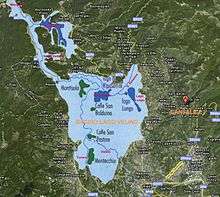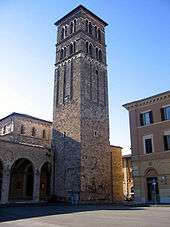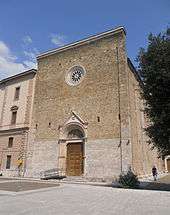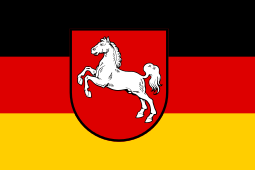Rieti
| Rieti | |||
|---|---|---|---|
| Comune | |||
| Comune di Rieti | |||
|
The city centre of Rieti as seen from San Mauro hill, east of the city. In the background, the Rieti valley enclosed by the Sabine mountains; in the foreground, the Velino river. | |||
| |||
 Rieti Location of Rieti in Italy | |||
| Coordinates: 42°24′N 12°52′E / 42.400°N 12.867°ECoordinates: 42°24′N 12°52′E / 42.400°N 12.867°E | |||
| Country | Italy | ||
| Region | Lazio | ||
| Province / Metropolitan city | Rieti (RI) | ||
| Frazioni | Case San Benedetto, Casette, Castelfranco, Cerchiara, Chiesa Nuova, Cupaello, Lisciano, Lugnano, Maglianello, Moggio, Piane di Poggio Fidoni, Piani di Sant'Elia, Piè di Moggio, Poggio Fidoni, Poggio Perugino, San Giovanni Reatino, Sant'Elia, Vaiano, Vazia | ||
| Government | |||
| • Mayor | Simone Petrangeli (SEL) | ||
| Area | |||
| • Total | 206.52 km2 (79.74 sq mi) | ||
| Elevation | 405 m (1,329 ft) | ||
| Population (30 April 2008) | |||
| • Total | 47,745 | ||
| • Density | 230/km2 (600/sq mi) | ||
| Demonym(s) | Reatini | ||
| Time zone | CET (UTC+1) | ||
| • Summer (DST) | CEST (UTC+2) | ||
| Postal code | 02100 | ||
| Dialing code | 0746 | ||
| Patron saint | St. Barbara | ||
| Saint day | December 4 | ||
| Website | Official website | ||
Rieti (Italian: [ˈrjɛːti]; Latin: Rĕā́tĕ) is a city and comune in Lazio, central Italy, with a population of c. 47,700. It is the capital of province of Rieti and see of the diocese of Rieti, as well as the modern capital of the Sabina region.
The town centre rests on a small hilltop, commanding from the southern edge the wide Rieti valley, at the bottom of Sabine mountains and of monti Reatini, among which mount Terminillo. The plain was once a large lake, drained by ancient Romans, now the fertile basin of the Velino River. Only the small Ripasottile and Lungo lakes remain of the original large one.
History

Prehistory
According to the legend, Reate was founded by Rea, a divinity (that would be the origin of the town name). It was founded at the beginning of the Iron Age (9th–8th century BC).
Probably in earlier times the lands around Rieti were inhabited by Umbri, then by Aborigines and later on by Sabines, who reached the lands sited in the nearby of Tevere river.
Ancient era
Reate was originally a major site of the Sabine nation well before the foundation of Rome. According to the legend, when Romulus founded Rome, Romans kidnapped Sabine women in order to populate the town (The Rape of the Sabine Women). So there was a war between Romans and Sabines. The battle of the Lacus Curtius came to an end only when the women threw themselves among the armies, begging for people who were by then relatives to stop fighting. Romulus and Titus Tatius reprieved and a collaboration between the two people started. According to a version more based on history, Sabines settled on the Quirinale because of their continuous need and search for plain grazing-lands.
After the definitive Roman conquest, carried out by Manius Curius Dentatus in the late 3rd century BC (290 BC), the village became a strategic point in the early Italian road network, dominating the "salt" track (known as Via Salaria) that linked Rome to the Adriatic Sea through the Apennines. Many lands of Reate and Amiternum were confiscated and allocated to Romans. At the very beginning, Sabines were offered Roman citizenship but with no right of voting, but yet in 268 BC they gained the full citizenship, being included in two new tribes (Velina and Quirina).

Curius Dentatus drained a large portion of the lake by making the Velino a distributary of the Nera river (thus giving birth to Marmore falls). The wide area once occupied by the lake turned into a fertile plain. Following Roman customs, the land was split into characteristic square allotments. The town itself underwent significant development, being re-organised according to typical Roman urbanistic standards (e.g., two orthogonal roads make up the settlement's backbone), and was fortified with strong walls. A stone bridge was laid across the Velino river, and a large viaduct was built to bring goods from the Salaria road directly to Rieti's southern door.
Roman Reate receives a number of mentions in Latin literature, thanks to its flourishing soil, its valued assets, and some peculiarities of the surroundings (such as wandering islands and hollow-subsurfaced fields). Cicero, for instance, describes the tensions between Reate and Interamna (Terni) following the lake drainage, and refers to the country houses (villae) that his friend Q. Axius owned in the plain.
One of the most important Sabine family gaining success in Rome was the Gens Flavia, from which Emperor Titus Flavius Vespasianus (who started the building of Colosseum, also known as amphitheatrum flavius) had birth.
The Reatin poet and writer Marcus Terentius Varro was born in 116 BC and he is usually referred to as the father of Roman erudition.
Middle Ages
After the fall of the Western Roman Empire Rieti suffered destruction by Barbarians, but never ceased to be an important gastaldate during the Lombard domination, as part of the Duchy of Spoleto. Under the Franks, it was county capital. It was sacked by the Saracens in the 9th and 10th century and by the Norman king Roger II of Sicily in 1149.
The city was rebuilt with the help of the Roman comune, and from 1198 was also a free commune, of Guelph orientation, with a podestà of its own.

As a favourite Papal seat, Rieti was the place of important historical events: Constance of Hauteville married here by proxy Emperor Henry VI (1185). Charles I of Anjou was crowned King of Apulia, Sicily and Jerusalem by Pope Nicholas I in 1289. Pope Gregory IX celebrated canonized St. Dominic in Rieti (1234).
Late Middle Ages and modern era
After the Papal seat had been moved to Avignon, Rieti was conquered by the King of Naples, while inner struggles between Guelphs and Ghibellines broke out. In 1354 it was won back by Cardinal Albornoz, and it later became a feudal seignory of the Alfani family within the Papal States. More of the surrounding plain was drained in the following century, but this led to confrontation with the neighboring Terni.
Rieti was province capital of the Papal States from 1816 to 1860. After the unification of Italy, it was initially part of Umbria, being annexed to Lazio in 1923. It became the provincial capital on January 2, 1927.
Climate
| Climate data for Rieti | |||||||||||||
|---|---|---|---|---|---|---|---|---|---|---|---|---|---|
| Month | Jan | Feb | Mar | Apr | May | Jun | Jul | Aug | Sep | Oct | Nov | Dec | Year |
| Average high °C (°F) | 8 (46) |
10 (50) |
13 (55) |
17 (63) |
22 (72) |
25 (77) |
29 (84) |
29 (84) |
25 (77) |
20 (68) |
14 (57) |
9 (48) |
18.4 (65.1) |
| Average low °C (°F) | 1 (34) |
0 (32) |
2 (36) |
5 (41) |
8 (46) |
11 (52) |
13 (55) |
13 (55) |
11 (52) |
7 (45) |
4 (39) |
1 (34) |
6.3 (43.4) |
| Average precipitation mm (inches) | 111 (4.37) |
110 (4.33) |
95 (3.74) |
93 (3.66) |
75 (2.95) |
70 (2.76) |
35 (1.38) |
55 (2.17) |
87 (3.43) |
106 (4.17) |
171 (6.73) |
146 (5.75) |
1,154 (45.44) |
| Source: [1] | |||||||||||||
Main sights




.jpg)
The ancient Sabine and Roman city was crowded with buildings, including baths (thermae). Only scarce remains were found during excavations in 19th and 20th century: the foundations of a large temple, the stone floor of the main square (forum), walls from private houses, concrete vaults, statues and pottery items. The most striking remains are the stone bridge across the Velino river and the viaduct.
Piazza San Rufo is traditionally considered to be the exact centre of Italy (Latin Umbilicus Italiae).
Other sights include:
- Rieti Cathedral: Construction started in 1109 over a pre-existing basilica, was consecrated in 1225 and almost entirely rebuilt in 1639. It has a stunning Romanesque bell tower from 1252. The entrance portico leads to a 13th-century portal. The interior, on Latin cross plan with one nave and two aisles, has mainly Baroque decorations, including a St. Barbara sculpted by Giannantonio Mari (1657), probably designed by Bernini. Antoniazzo Romano contributed a fresco. It also houses canvases from 16th and 17th centuries. The crypt corresponds to the most ancient part of the church, consecrated in 1157. The Baptistery has an elegant 15th-century baptismal font.
- Palazzo Vescovile ("Bishops Palace" or "Papal Palace"): Construction begun in 1283. Noteworthy are the loggia and eight Renaissance-style windows from 1532. The lower floor is occupied by the so-called "Volte del Vescovado", a great portico with two naves of Gothic arcades. The Grand Hall houses the Diocese Gallery.
.jpg)
- Palazzo Comunale ("Town Hall", 13th century, rebuilt in the 18th century), facing Piazza Vittorio Emanuele II, a square corresponding to the ancient Roman forum. The Palace houses the Town Museum which hosts works by Antoniazzo Romano, Antonio Canova, Bertel Thorwaldsen.
- Palazzo del Governo, with a noble loggia from 1596.
- Bishop's Arch, a bridge built by Boniface VIII.
- San Pietro Martire - church of St. Peter Martyr (13th century), with luxurious golden Baroque decorations. It has a Presentation of Christ to the Temple by Giovanni Battista Gaulli.
- Palazzo Vicentini, attributed to Giuliano da Sangallo the Younger.
- Walls of Rieti; Walls date from first half of the 13th century, with characteristical rounded and square towers.
- Sant'Agostino: 13th century Gothic-style church restored in the 18th century). The portal has a fresco of Madonna with Child and Saints Augustine and Nicholas (1354) of Sienese school.
- Santa Maria in Vescovio, a church built in the 8th century and subsequently modified to the current 12th century Romanesque appearance. The interior has a single nave and frescoes from the late 13th-early 14th centuries, depicting the Last Judgement and scenes from the Old and New Testament.
- San Francesco: church begun in 1245, radically restored in 1636). The interior has a single nave. The original frescoes from the 14th-15th centuries depicting scenes from the life of St. Francis and the Virgin and Child[2] are now in the Diocese Museum and in the Palazzo Vescovile.
- Palazzo Vecchiarelli: late Renaissance palace designed by Carlo Maderno.
Also interesting are the sights in the Lake Lungo and Ripasottile Natural Preserve, and the Mount Terminillo.
Notable people
.jpg)
- Marcus Terentius Varro (116–27 BC), Roman scholar and writer.
- Antonio Gherardi (1638–1702) Italian painter, architect, and sculptor (stuccoist).
- Giuseppe Ottavio Pitoni (1657–1743), composer.
- Giuseppe Ferrari (1840–1905), painter.
- Elio Augusto Di Carlo (1918–1998) Italian ornithologist, historian and physician.
- Renzo De Felice (1929–1996), historian of Fascism.
- Kobe Bryant NBA Superstar Grew up in Rieti
Twin cities
 Ito, Japan, since 1985[3]
Ito, Japan, since 1985[3] Saint-Pierre-lès-Elbeuf, Seine-Maritime, Normandy, France, since 2000[4]
Saint-Pierre-lès-Elbeuf, Seine-Maritime, Normandy, France, since 2000[4] Nordhorn, Lower Saxony, Germany, since 2010[5]
Nordhorn, Lower Saxony, Germany, since 2010[5]
Transportation
Rieti is not crossed by any of Autostrade of Italy; all roads connecting Rieti with other cities are therefore state highways (strade statali), in most cases single carriageway roads.
The most important road link is strada statale 4 Via Salaria, which connects Rieti with Rome at south and with Ascoli Piceno and the Adriatic sea at north, just like the ancient Via Salaria roman road. Other major roads include the strada statale 79 Ternana, which connects Rieti with Terni and with the Orte gate of Autostrada A1; strada statale 17, which branches from strada statale 4 in Antrodoco, connects Rieti with L'Aquila; strada statale 578 Salto Cicolana, which connects Rieti with Avezzano and with the Salto valley gate of A24 and A25 autostradas.
Rieti's railway station is located on the regional, low traffic Terni–Sulmona railway, with trains to Terni and L'Aquila.[6] There is no direct railway link between Rieti and Rome, as the costruction of such railway has been subject of a long debate but never took place;[7] Rome can be reached by catching a train to the Terni station, where direct trains to Rome can be found.[8]
The Rieti Airport is mainly used by small private planes and for gliding.
Sport
- Stadio Raul Guidobaldi in Rieti hosts every year since 1971 the Rieti Meeting, an international athletics event known for the many world records settled here, to the point that Steve Cram defined Rieti "a Mecca for middle-distance runners looking for fast times".[9] Example of these include Jamaican sprinter Asafa Powell, who ran the then world record time of 9.74 s in the 100 meters at the Rieti meeting on September 9, 2007 (the record stood until Usain Bolt broke it on 31 May 2008) and Kenyan runner David Rudisha, who ran a world record time of 1:41.01 in the 800 meters at the Rieti meeting on August 29, 2010 (the record stood until Rudisha beat his own mark at the 2012 Summer Olympics in London, running a 1:40:91 on August 9, 2012).
- The 2013 edition of European Athletics Junior Championships were held at the Stadio Raul Guidobaldi in Rieti.[10]

- Rieti is the base of a strong athletics movement, with an average of one athlete every forty inhabitants.[11] Atletica Studentesca Andrea Milardi, formerly known as Atletica Studentesca CARIRI, is the main athletics team and has been the place where many Italian athletes grew up to become part of the Italy national athletics team. Among them is Andrew Howe, born in Los Angeles but grown up in Rieti,[12] Angelo Cipolloni, Patrizia Spuri, Roberto Donati, Lorenzo Valentini and many others.
- Rieti was home to an important basketball team, AMG Sebastiani, which played in the PalaSojourner arena and won the 1979-80 FIBA Korać Cup, whose players included Willie Sojourner and Joe Bryant (who played in Rieti from 1984 to 1986 and then another 5 years in Italy; his son Kobe Bryant, now also an NBA player, attended school in Rieti and as a result speaks fluent Italian to this day[13][14]). After the dissolution of AMG Sebastiani, newer teams were formed such as Nuova AMG Sebastiani, which managed for some years to regain a spot in Italian basket's first division.
- The biggest football club in Rieti is Serie D team FC Rieti, which plays at the Stadio Centro d'Italia – Manlio Scopigno. Futsal team Real Rieti Calcio a 5 plays in Italy's premier league.
References
- ↑ "Climate averages: Rieti, Italy". EuroWeather. Retrieved 5 December 2008.
- ↑ Péter Bokody, "Secularization and Realistic Turn in Italy: Antonio Fissiraga's Funerary Monument in Lodi," IKON: Journal of Iconographic Studies 5 (2012): 351-363. https://www.academia.edu/1796258/Secularization_and_Realistic_Turn_in_Italy_Antonio_Fissiragas_Funerary_Monument_in_Lodi
- ↑ "A Ito una delegazione reatina per i trent'anni del Gemellaggio". Official site of the Municipality of Rieti. 2 July 2015. Retrieved 26 September 2016.
- ↑ "COMUNE DI RIETI: DIECI ANNI DAL GEMELLAGGIO CON SAINT PIERRE LES ELBEUF". Rieti in vetrina. 8 September 2010. Retrieved 26 September 2016.
- ↑ "Gemellaggio tra le città di Nordhorn e Rieti". Official site of the Municipality of Rieti. Archived from the original on 9 May 2010. Retrieved 26 September 2016.
- ↑ Trains departing from the station of Rieti
- ↑ Aldo Fabriani (21 October 2006). "LA lunga storia della questione ferroviaria nel Reatino verrà ripercorsa ...". Il Tempo - edition of Rieti. Retrieved 19 June 2016.
- ↑ Trains departing from the station of Terni
- ↑ Steve Cram. Why is a small town in Italy such a mecca for world records? The Guardian, 11 September 2007.
- ↑ Rieti 2013 is "Moving by Nature". European Athletics. Retrieved on 2016-09-26.
- ↑ Valerio Vecchiarelli (30 July 2003). "A Rieti tutti in pista: mille tesserati su 40 mila abitanti". Corriere della Sera. p. 45. Archived from the original on 19 December 2015. Retrieved 29 February 2016.
- ↑ Andrew Howe, by Giorgio Dell'Arti and Massimo Parrini, in Catalogo dei viventi 2009, Marsilio publishing house.
- ↑ Golianopoulos, Thomas (April 12, 2013). "The Secret History of Kobe Bryant's Rap Career". grantland.com. Archived from the original on April 12, 2013.
- ↑ Intervista Kobe Bryant in italiano su Sportitalia 1^PARTE. YouTube. Sportitalia. April 8, 2007. Retrieved June 28, 2008.
External links
| Wikisource has the text of the 1905 New International Encyclopedia article Rieti. |


_01.jpg)